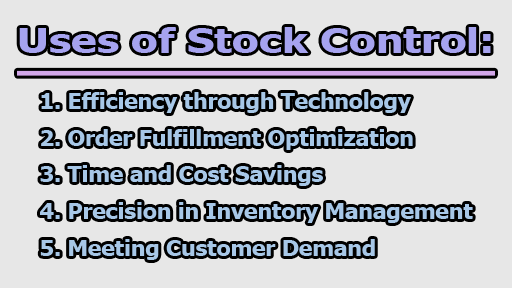Purposes and Uses of Stock Control:
In the dynamic world of commerce, where tangible goods are bought, sold, and distributed, the management of inventory stands as a cornerstone of business operations. Stock control, often underestimated but profoundly significant, is indispensable for ensuring that a business runs smoothly while maximizing profits and customer satisfaction. Let’s delve into the purposes and uses of stock control and how it contributes to the success of businesses.
Purposes of Stock Control:
Stock control is the backbone of businesses dealing in tangible goods, ensuring that they always have the right amount of inventory to meet customer demand while minimizing costs associated with procurement and storage. Several essential purposes underscore the importance of stock control in business operations:
1. Avoiding Stockouts: Stockouts represent a significant challenge for businesses, as they occur when a company runs out of inventory to meet customer demand. For businesses, the repercussions of stockouts can be severe, ranging from lost sales and revenue to diminished customer trust and loyalty. Therefore, one of the primary purposes of stock control is to preemptively address and mitigate the risk of stockouts.
Stock control systems provide businesses with the tools and insights necessary to anticipate fluctuations in demand and adjust inventory levels accordingly. By leveraging historical sales data, market trends, and forecasting techniques, businesses can accurately predict future demand for their products. Armed with this information, companies can proactively reorder supplies, replenishing stock levels before they reach critical lows.
Moreover, effective stock control enables businesses to optimize their reorder points and lead times, ensuring that they maintain adequate inventory levels at all times. By implementing robust inventory management systems and automating reorder procedures, companies can minimize the likelihood of stockouts and uphold customer satisfaction and loyalty.
2. Simplifying Processes: In the fast-paced world of business, efficiency and productivity are paramount. However, manual inventory management processes, such as spreadsheet tracking and manual stock counts, can be time-consuming, error-prone, and inefficient. Recognizing this, another critical purpose of stock control is to simplify and streamline operational processes within the organization.
Effective stock control systems leverage technology and automation to streamline inventory management processes, reducing reliance on manual tasks and minimizing the potential for errors. For example, barcode scanning technology and inventory management software enable businesses to track inventory in real-time, accurately record transactions, and reconcile inventory levels effortlessly.
Moreover, stock control systems facilitate the optimization of warehouse layouts and storage configurations, ensuring that inventory is organized, accessible, and efficiently managed. By implementing standardized procedures and workflows, businesses can enhance operational efficiency, reduce labor costs, and optimize resource allocation.
3. Cost Management: In today’s competitive business landscape, cost management is a critical factor influencing profitability and sustainability. Efficient stock control plays a pivotal role in managing expenses related to inventory handling, storage, and obsolescence, thereby optimizing overall operational costs.
One of the primary objectives of stock control is to minimize the costs associated with excess inventory while ensuring that adequate stock levels are maintained to meet customer demand. Excess inventory ties up valuable capital and warehouse space, leading to increased holding costs, depreciation, and the risk of inventory obsolescence. On the other hand, insufficient inventory levels can result in missed sales opportunities, rush orders, and expedited shipping costs.
Effective stock control systems enable businesses to strike the right balance between inventory levels and turnover rates, optimizing inventory holding costs and maximizing inventory turnover. By leveraging demand forecasting, inventory optimization techniques, and just-in-time inventory management principles, companies can minimize the carrying costs associated with excess inventory while mitigating the risks of stockouts.
Furthermore, stock control facilitates the identification of cost-saving opportunities throughout the supply chain, from sourcing and procurement to distribution and logistics. By analyzing supplier performance, negotiating favorable terms, and implementing lean inventory practices, businesses can reduce procurement costs and improve overall cost efficiency.
4. Optimizing Stock Levels: Maintaining optimal stock levels is crucial for businesses to ensure that they neither overstock nor understock their inventory. Overstocking ties up capital, occupies valuable warehouse space, and increases holding costs, while understocking leads to lost sales opportunities, dissatisfied customers, and potential damage to the company’s reputation. Therefore, one of the primary purposes of stock control is to optimize stock levels, striking a delicate balance between supply and demand.
Stock control systems provide businesses with the tools and insights necessary to determine the appropriate inventory levels for each product in their portfolio. Through historical sales data analysis, demand forecasting, and inventory optimization techniques, companies can identify trends and patterns in customer demand, enabling them to forecast future demand accurately.
By setting optimal reorder points and safety stock levels, businesses can ensure that they maintain adequate inventory levels to meet expected demand while minimizing the risk of stockouts. Additionally, inventory turnover rates and carrying costs are closely monitored and managed to prevent excess inventory accumulation and obsolescence.
Moreover, effective stock control enables businesses to implement just-in-time inventory management practices, where inventory is replenished only when needed, minimizing holding costs and improving cash flow. By aligning inventory levels with demand fluctuations, companies can optimize warehouse space utilization, reduce carrying costs, and improve overall operational efficiency.
5. Decision-Making and Data Analysis: Stock control systems generate valuable data on demand trends, inventory levels, and turnover rates, providing businesses with actionable insights to support decision-making processes. By leveraging data analysis techniques, companies can make informed decisions regarding product assortment, pricing strategies, and purchasing practices, thereby enhancing operational efficiency and driving revenue growth.
Through data-driven decision-making, businesses can optimize product offerings based on customer preferences and market trends, improving the relevance and competitiveness of their product portfolio. Additionally, pricing strategies can be adjusted based on demand elasticity and competitive positioning, maximizing profitability while maintaining customer value perception.
Furthermore, data analysis enables businesses to identify opportunities for process improvement and cost optimization throughout the supply chain. By analyzing supplier performance, transportation costs, and inventory carrying costs, companies can identify inefficiencies and implement strategies to enhance supply chain efficiency and reduce costs.
Uses of Stock Control:
The top uses of stock control are as follows:
1. Efficiency through Technology: In today’s digital age, technology plays a vital role in driving efficiency and productivity within businesses. Stock management devices and software, such as barcode scanners and inventory management systems, represent invaluable tools that significantly increase operational efficiency.
By automating manual tasks and minimizing human errors, these technological solutions streamline inventory management processes, allowing businesses to allocate resources more effectively. For instance, barcode scanners enable quick and accurate tracking of inventory movement, reducing the time and effort required for manual data entry.
Moreover, inventory management software provides real-time visibility into stock levels, reorder points, and demand trends, empowering businesses to make informed decisions promptly. By harnessing the power of technology, businesses can optimize their operations, reduce costs, and enhance overall efficiency.
2. Order Fulfillment Optimization: Organized warehouses are the cornerstone of efficient order fulfillment processes. Stock control ensures that inventory is properly organized, labeled, and stored, enabling seamless retrieval and packaging of products for shipment.
By maintaining accurate inventory records and implementing efficient warehouse layouts, businesses can accelerate the order fulfillment process, reducing lead times and enhancing customer satisfaction. This optimization not only improves operational efficiency but also fosters customer loyalty and repeat business.
Furthermore, stock control facilitates inventory visibility across multiple sales channels, enabling businesses to fulfill orders from various sources promptly. This flexibility allows companies to adapt to changing customer preferences and market dynamics, staying ahead of the competition.
3. Time and Cost Savings: Effective inventory management translates into significant time and cost savings for businesses. By reducing the need for manual stock takes and minimizing excess inventory costs, stock control streamlines operations and optimizes resource allocation.
Automated inventory tracking and replenishment processes eliminate the need for labor-intensive manual tasks, freeing up valuable time for employees to focus on more strategic initiatives. This increased productivity not only reduces labor costs but also enhances overall operational efficiency.
Moreover, stock control helps businesses minimize excess inventory holding costs by maintaining optimal stock levels. By accurately forecasting demand and adjusting inventory levels accordingly, companies can avoid overstocking and minimize the risk of inventory obsolescence.
4. Precision in Inventory Management: Stock control enables businesses to achieve precision in inventory management, ensuring that the right amount of inventory is available to meet customer demand without overstocking or understocking. By leveraging demand forecasting techniques and inventory optimization tools, companies can determine the precise inventory levels needed to support sales and production operations.
Maintaining optimal inventory levels not only minimizes holding costs but also reduces the risk of stockouts and lost sales opportunities. By striking the right balance between supply and demand, businesses can improve inventory turnover rates and maximize profitability.
Furthermore, stock control enables businesses to implement just-in-time inventory management practices, where inventory is replenished only when needed. This lean approach reduces inventory carrying costs and improves cash flow, enhancing overall operational efficiency.
5. Meeting Customer Demand: Ultimately, the primary goal of stock control is to ensure that businesses can promptly and effectively meet customer demand. By maintaining optimal inventory levels and streamlining order fulfillment processes, companies can enhance their ability to deliver products to customers in a timely manner.
Meeting customer demand not only fosters customer satisfaction but also enhances brand reputation and loyalty. Satisfied customers are more likely to return for future purchases and recommend the business to others, driving revenue growth and long-term success.
In conclusion, stock control serves as a linchpin in the success of businesses that deal in tangible goods. By fulfilling crucial purposes such as avoiding stockouts, simplifying processes, managing costs, and optimizing stock levels, stock control ensures operational efficiency and customer satisfaction. Additionally, its diverse uses, ranging from leveraging technology to meeting customer demand, underscore its significance in today’s competitive business landscape. As businesses strive for success and growth, embracing effective stock control practices becomes not just beneficial but essential. Whether through implementing robust stock control systems or leveraging online finance courses to enhance understanding, businesses can harness the power of stock control to streamline operations and achieve enduring success.

Library Lecturer at Nurul Amin Degree College










